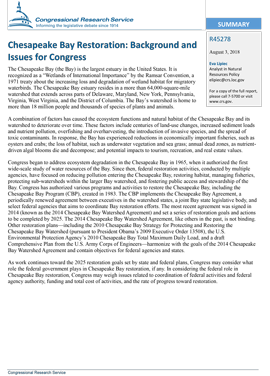In 2010, CBF and our co-plaintiffs settled a lawsuit with the Environmental Protection Agency (EPA) that included a Clean Water Act provision called the Chesapeake Bay Total Maximum Daily Load or TMDL, which provides science-based, enforceable limits on the amount of pollution entering the Chesapeake in order to remove the Bay from the federal "dirty waters" list.
In addition to the settlement, the six Bay states and the District of Columbia agreed to develop individual plans and milestones to achieve those limits by 2025, and EPA committed to holding them accountable and imposing consequences for failure if necessary.
Together, the limits, plans, milestones, and consequences make up the Chesapeake Clean Water Blueprint.
What Will the Blueprint Do?
If fully implemented, the Chesapeake Clean Water Blueprint will ensure pollution reductions in the Chesapeake Bay by 2025 that will lead to the "fishable, swimmable" waters promised by the Clean Water Act of 1972. The Blueprint does three things:
- ensures everyone shares in the responsibility for cleaning up our waterways;
- sets two-year, incremental pollution-reduction goals—known as milestones—to keep progress on track; and
- imposes consequences for failure, ensuring states and localities will meet their responsibilities.
Clean water is critical to the health, outdoor heritage, and quality of life of communities throughout the watershed. The steps needed to clean up not only the Bay—but also local rivers and streams—will support local businesses, create jobs, and provide additional environmental benefits. A peer-reviewed economic report estimated the economic value of implementing the practices that will result in a restored Chesapeake Bay will produce natural benefits of more than $22 billion annually.
This Time Really Is Different
What makes the Blueprint better than previous efforts? It has teeth. For the first time, the states have each committed to two-year incremental milestones of pollution reduction. EPA has committed to implementing consequences for failure. If the Blueprint is fully implemented, the Bay should come off the impaired waters list.
Obstacles the Blueprint Faces
EPA's failure to require Pennsylvania and New York to develop implementation plans that will achieve the 2025 Bay restoration goals puts the success of the Chesapeake Clean Water Blueprint at risk. (See Pennsylvania's plan.) On September 10, 2020, CBF and partners filed suit against EPA for abdicating its responsibilities under the Clean Water Act.
And even as the Bay makes progress thanks to the Blueprint, it faces new threats from climate change and added pollution loads from the Conowingo Dam.
What's the Status of the Blueprint?
See our State of the Blueprint assessment.
You Can Help
The Bay's problems have been identified; we have the know-how and tools to fix them; and the health, economic, and quality of life benefits of a restored Chesapeake Bay outweigh cleanup costs. If we work together to make the Blueprint work, many scientists believe the Bay will reach a tipping point when improvements outpace pollution and the Bay rebounds exponentially.
It's critically important that citizens get involved. And it's not too hard.
- Join CBF's Action Network to receive e-mails regarding actions you can take to save the Bay.
- Tell your Congressman and Senators that clean water is important to you and urge them to support clean water legislation and oppose legislation that would derail the Bay TMDL by calling, writing, or visiting them or attending one of their local town halls.
- Ditto your state and local representatives and ask them to finalize and implement strong plans to achieve the Bay pollution limits and provide ample Bay funding. Attend a public meeting of your local governing body.
- Write a letter of support to the editor of your local newspaper.
- Attend a public meeting of local governing bodies.
- Walk the walk. Reduce pollution from your home, back yard, school, or business.



